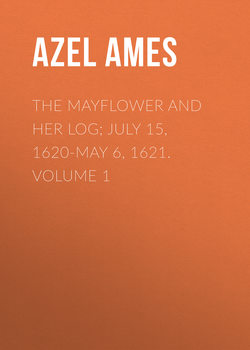Читать книгу The Mayflower and Her Log; July 15, 1620-May 6, 1621. Volume 1 - Azel Ames - Страница 5
CHAPTER II
THE MAY-FLOWER'S CONSORT THE SPEEDWELL
ОглавлениеThe SPEEDWELL was the first vessel procured by the Leyden Pilgrims for the emigration, and was bought by themselves; as she was the ship of their historic embarkation at Delfshaven, and that which carried the originators of the enterprise to Southampton, to join the MAY-FLOWER,– whose consort she was to be; and as she became a determining factor in the latter's belated departure for New England, she may justly claim mention here as indeed an inseparable "part and parcel" of the May- FLOWER'S voyage.
The name of this vessel of associate historic renown with the MAY-FLOWER was even longer in finding record in the early literature of the Pilgrim hegira than that of the larger It first appeared, so far as discovered, in 1669—nearly fifty years after her memorable service to the Pilgrims on the fifth page of Nathaniel Morton's "New England's Memorial."
Davis, in his "Ancient Landmarks of Plymouth," makes a singular error for so competent a writer, when he says: "The agents of the company in England had hired the SPEEDWELL, of sixty tons, and sent her to Delfthaven, to convey the colonists to Southampton." In this, however, he but follows Mather and the "Modern Universal History," though both are notably unreliable; but he lacks their excuse, for they were without his access to Bradford's "Historie." That the consort-pinnace was neither "hired" nor "sent to Delfthaven" duly appears.
Bradford states the fact,—that "a smale ship (of some 60 tune), was bought and fitted in Holand, which was intended to serve to help to transport them, so to stay in ye countrie and atend ye fishing and such other affairs as might be for ye good and benefite of ye colonie when they come ther." The statements of Bradford and others indicate that she was bought and refitted with moneys raised in Holland, but it is not easy to understand the transaction, in view of the understood terms of the business compact between the Adventurers and the Planters, as hereinafter outlined. The Merchant Adventurers—who were organized (but not incorporated) chiefly through the activity of Thomas Weston, a merchant of London, to "finance" the Pilgrim undertaking—were bound, as part of their engagement, to provide the necessary shipping,' etc., for the voyage. The "joint-stock or partnership," as it was called in the agreement of the Adventurers and Planters, was an equal partnership between but two parties, the Adventurers, as a body, being one of the co-partners; the Planter colonists, as a body, the other. It was a partnership to run for seven years, to whose capital stock the first- named partner (the Adventurers) was bound to contribute whatever moneys, or their equivalents,—some subscriptions were paid in goods,—were necessary to transport, equip, and maintain the colony and provide it the means of traffic, etc., for the term named. The second-named partner (the Planter body) was to furnish the men, women, and children,—the colonists themselves, and their best endeavors, essential to the enterprise,—and such further contributions of money or provisions, on an agreed basis, as might be practicable for them. At the expiration of the seven years, all properties of every kind were to be divided into two equal parts, of which the Adventurers were to take one and the Planters the other, in full satisfaction of their respective investments and claims. The Adventurers' half would of course be divided among themselves, in such proportion as their individual contributions bore to the sum total invested. The Planters would divide their half among their number, according to their respective contributions of persons, money, or provisions, as per the agreed basis, which was:
